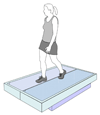Walking with increased ankle pushoff decreases hip muscle moments
- PMID: 18606419
- PMCID: PMC2562040
- DOI: 10.1016/j.jbiomech.2008.05.013
Walking with increased ankle pushoff decreases hip muscle moments
Abstract
In a simple bipedal walking model, an impulsive push along the trailing limb (similar to ankle plantar flexion) or a torque at the hip can power level walking. This suggests a tradeoff between ankle and hip muscle requirements during human gait. People with anterior hip pain may benefit from walking with increased ankle pushoff if it reduces hip muscle forces. The purpose of our study was to determine if simple instructions to alter ankle pushoff can modify gait dynamics and if resulting changes in ankle pushoff have an effect on hip muscle requirements during gait. We hypothesized that changes in ankle kinetics would be inversely related to hip muscle kinetics. Ten healthy subjects walked on a custom split-belt force-measuring treadmill at 1.25m/s. We recorded ground reaction forces and lower extremity kinematic data to calculate joint angles and internal muscle moments, powers and angular impulses. Subjects walked under three conditions: natural pushoff, decreased pushoff and increased pushoff. For the decreased pushoff condition, subjects were instructed to push less with their feet as they walked. Conversely, for the increased pushoff condition, subjects were instructed to push more with their feet. As predicted, walking with increased ankle pushoff resulted in lower peak hip flexion moment, power and angular impulse as well as lower peak hip extension moment and angular impulse (p<0.05). Our results emphasize the interchange between hip and ankle kinetics in human walking and suggest that increased ankle pushoff during gait may help to compensate for hip muscle weakness or injury and reduce hip joint forces.
Conflict of interest statement
The authors affirm that they have no financial affiliation or involvement with any commercial organization that has direct financial interest in any matter included in this manuscript.
Figures



Similar articles
-
Females with hip-related pain demonstrate reduced kinetics at the hip and ankle during terminal stance of gait.Gait Posture. 2023 Sep;105:99-103. doi: 10.1016/j.gaitpost.2023.07.284. Epub 2023 Jul 26. Gait Posture. 2023. PMID: 37515892 Free PMC article.
-
Increased ankle pushoff alters frontal-plane hip and knee mechanics.J Biomech. 2025 Apr;183:112623. doi: 10.1016/j.jbiomech.2025.112623. Epub 2025 Mar 8. J Biomech. 2025. PMID: 40107188
-
Effect of increased pushoff during gait on hip joint forces.J Biomech. 2015 Jan 2;48(1):181-5. doi: 10.1016/j.jbiomech.2014.10.033. Epub 2014 Nov 12. J Biomech. 2015. PMID: 25468661 Free PMC article.
-
Contributions to the understanding of gait control.Dan Med J. 2014 Apr;61(4):B4823. Dan Med J. 2014. PMID: 24814597 Review.
-
Immediate effects of different ankle pushoff instructions during walking exercise on hip kinematics and kinetics in individuals with total hip arthroplasty.Gait Posture. 2011 Apr;33(4):609-14. doi: 10.1016/j.gaitpost.2011.01.018. Epub 2011 Feb 21. Gait Posture. 2011. PMID: 21334898 Clinical Trial.
Cited by
-
Muscle metabolic energy costs while modifying propulsive force generation during walking.Comput Methods Biomech Biomed Engin. 2021 Nov;24(14):1552-1565. doi: 10.1080/10255842.2021.1900134. Epub 2021 Mar 22. Comput Methods Biomech Biomed Engin. 2021. PMID: 33749464 Free PMC article.
-
Females with hip-related pain demonstrate reduced kinetics at the hip and ankle during terminal stance of gait.Gait Posture. 2023 Sep;105:99-103. doi: 10.1016/j.gaitpost.2023.07.284. Epub 2023 Jul 26. Gait Posture. 2023. PMID: 37515892 Free PMC article.
-
Relative changes in ankle and hip control during bilateral joint movements in persons with multiple sclerosis.Clin Neurophysiol. 2014 Jun;125(6):1192-201. doi: 10.1016/j.clinph.2013.11.009. Epub 2013 Nov 21. Clin Neurophysiol. 2014. PMID: 24315810 Free PMC article. Clinical Trial.
-
Evolving Toward Subject-Specific Gait Rehabilitation Through Single-Joint Resistive Force Interventions.Front Neurorobot. 2020 Mar 12;14:15. doi: 10.3389/fnbot.2020.00015. eCollection 2020. Front Neurorobot. 2020. PMID: 32226372 Free PMC article.
-
How does ankle-foot orthosis stiffness affect gait in patients with lower limb salvage?Clin Orthop Relat Res. 2014 Oct;472(10):3026-35. doi: 10.1007/s11999-014-3661-3. Clin Orthop Relat Res. 2014. PMID: 24817379 Free PMC article.
References
-
- DeVita P, Hortobagyi T. Age causes a redistribution of joint torques and powers during gait. J.Appl.Physiol. 2000;88:1804–1811. - PubMed
-
- Doke J, Donelan JM, Kuo AD. Mechanics and energetics of swinging the human leg. J.Exp.Biol. 2005;208:439–445. - PubMed
-
- Farjo LA, Glick JM, Sampson TG. Hip arthroscopy for acetabular labral tears. Arthroscopy. 1999;15:132–137. - PubMed
-
- Garcia M, Chatterjee A, Ruina A, Coleman M. The simplest walking model: stability, complexity, and scaling. J.Biomech.Eng. 1998;120:281–288. - PubMed
Publication types
MeSH terms
Grants and funding
LinkOut - more resources
Full Text Sources
Other Literature Sources
Research Materials

